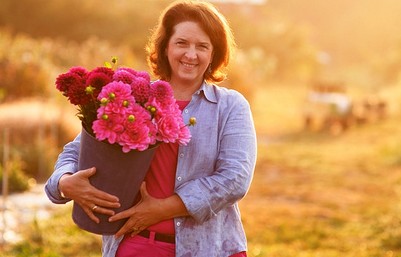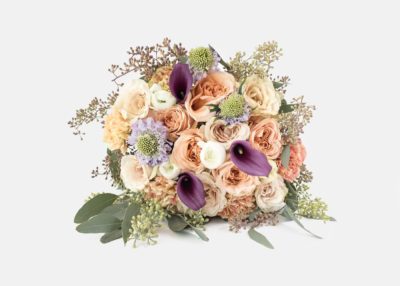There is a renaissance going on in the U.S. floral industry and you can witness the evidence in several beautiful ways:
1. More people, especially foodies, view flower farming as an integral part of American agriculture. You may think domestic flowers are cherished just for their beauty, but food producers also value flowers because they produce an essential source of nectar for pollinators.
2. More flower lovers are asking: “Who grew my flowers and what practices did they use?” Like wanting to know who produced the food on our table, we’re curious about the origin of flowers that adorn our dining tables.
3. And increasingly, consumers are thinking local when it comes to all their purchases, including flowers. We wonder how far those flowers, admittedly a perishable good, had to travel to reach our corner grocery store. Like the “food mile” calculation, there’s also a flower mile metric. Some may consider flowers a luxury good (for the record, I am not one of those people), but if you do, then that’s all the more reason to understand the transportation footprint for your purchases. There are online flower stores selling all kinds of fancy products, such as teacup flowers from Flowercard, but how do you know the origin of these flowers?
There is still some confusion about the importance of the why, who and where behind our flowers, though. Unless it’s an edible nasturtium in the bowl of mixed salad, we don’t eat flowers, right? Since we don’t eat flowers, why does it matter if they are sustainably grown? Why should we care about the place, people and practices behind that bunch of blooms wrapped in cellophane at the grocery store checkout line?

I argue that the origins and growing methods of flowers are vitally important.
It has been decades since the farm-to-table movement started. In fact, Alice Waters opened Chez Panisse in Berkeley, California, 40 years ago. Why has it taken flowers so long to catch up to food?
These questions are being asked in many consumer categories. We’re concerned about the origins of our fashion, our cars, materials used to build and furnish our homes, our kids’ toys, and so much more. Thankfully, this heightened consciousness has emerged just in time. When you take time to care about the origins of a bouquet, one that symbolizes all sorts of human events and emotions, you are joining this renaissance. When we know where our flowers come from and who grew them, we place a much higher value on those blooms. I call it the Slow Flowers Movement.
What’s the urgency? Here are some sobering statistics that might surprise you:
- 80 percent of cut flowers sold in the U.S. are imported
- 74 percent of Americans don’t know the source of the flowers they purchase
- 58 percent of Americans would choose American-grown flowers if given the option
Clearly there’s a disconnect between the floral status quo (mostly imports) and the floral IQ (what consumers actually know about their flowers).

Another recent study highlights “local” economic decisions as an important sustainability value. Ci (Conscientious innovation), a market research, information and consulting firm, surveyed a diverse cross-section of 5,000 North American consumers about their sustainable attitudes. Published as part of its SHIFT Report, the study found that “65 percent (of consumers) feel buying local and supporting locally-based businesses is an important sustainability issue, surpassing the importance of both global warming and buying organic.”
Buy-local sentiments are stimulating many facets of the U.S. economy. In the floral world, it means our American-grown purchases support family flower farms, create jobs, save farmland and stimulate economic development in rural and urban areas.
Yet it is a challenge for many consumers to identify American grown flowers in the marketplace. The just-launched Certified American Grown labeling program, designed for supermarkets and other mass-market retailers, will gradually appear on bouquets at the cash register. But for those who wish to source directly from flower farmers, or from floral designers and studios who choose American grown botanicals, I created the Slowflowers.com web site.
Slowflowers.com is a free, online directory to help consumers find bouquets, arrangements and direct-from-the-farm flowers that are local, seasonal and American grown. Nearly 400 flower vendors are listed on the site, small and large, in every region of the country. If you log onto Slowflowers.com, you can search by zip code, city, or category, to find the creative companies dedicated to domestic flower farming, and to truthfulness and transparency in their offerings. Can’t find a vendor close to you? The site also connects you with flower-sellers and florists who ship domestic flowers nationwide.
Some amazing people have joined the Slowflowers.com site. Meet Molly Oliver Culver, owner of Brooklyn-based Molly Oliver Flowers. She says: “At Molly Oliver Flowers, we source locally first: from Brooklyn urban farms doing great farm and sustainability education work, then on to regional farms bringing their bounty to farmers’ markets in the city, and finally on to NYC’s 28th Street, where local flowers exist, but do not reign — yet. It’s very exciting to imagine the possibilities of a thriving local flower industry again. We know flower farmers old and young, working hard to bring their blooms into the forefront of our American conscience, and to shed light on the ill effects free trade has had on communities abroad, where 80% of our flowers currently come from.”
Like Molly, I believe our conscious choices do make a difference, one flower stem at a time. Those purchasing decisions reverberate in our personal living spaces, throughout our local communities and in the larger environment. The next time you purchase flowers, it is my hope that you look closely at each bloom and consider the face of the farmer who grew it. Your choice will help save our domestic source of flowers.
Debra Prinzing is a Seattle-based outdoor living expert, author of 10 books on gardening and landscape design, and the leading advocate for American grown flowers. She is the creator of Slowflowers.com, the free, online directory to American grown flowers, coast-to-coast.
Read her books:



